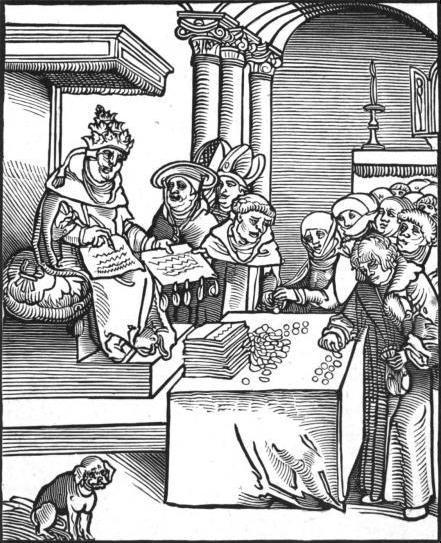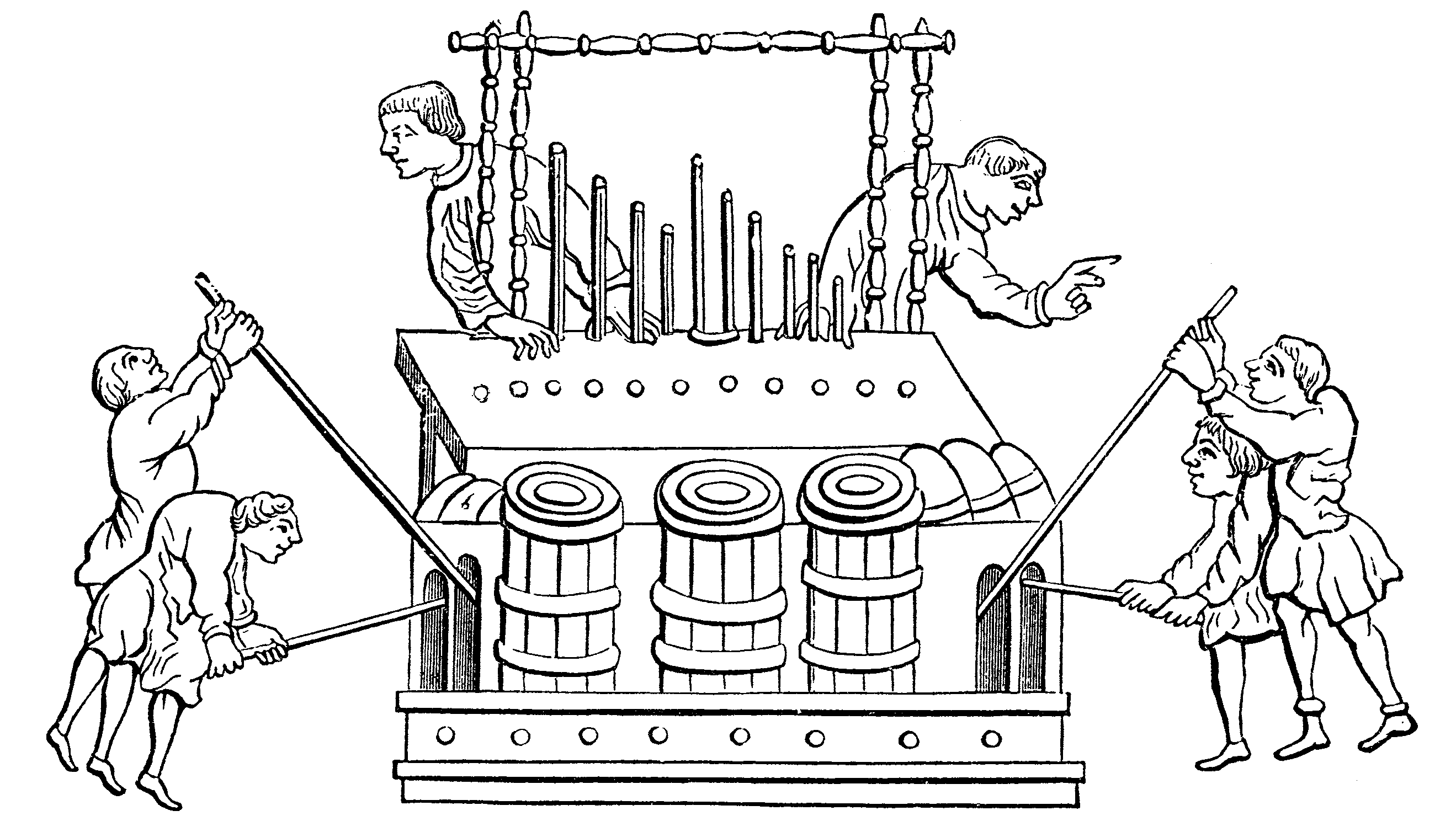Friday, December 25, 2015
"Direct Revelation" Says: No Immaculate Conception
"Berne [Switzerland] was the theater of one of the most reverberating scandals enacted by the contemporary church. A passionately contested theological issue of the day was whether the Virgin had been immaculately conceived. This was denied by the Dominicans and asserted by the Franciscans. Some of the Dominicans of the friary at Berne thought that the best way to settle the affair was to have a direct revelation. For their fraudulent purposes they conspired with John Jetzer, a lay brother admitted in 1506, who died after 1520. Whether as a tool in the hands of others, or as an imposter, Jetzer produced a series of bogus apparitions, bringing the Virgin on the stage and making her give details of her conception sufficiently gross to show that it took place in the ordinary, and not in the immaculate, manner. When the fraud was at last discovered by the authorities, four of the Dominicans involved were burnt at the stake." (121) --Preserved Smith, Reformation in Europe
Tuesday, December 22, 2015
Financing Salvation in the Early 16th Century
"One of the richest sources of ecclesiastical revenue was the sale of indulgences, or the remission by the pope of the temporal penalties of sin, both penance in this life and the pains of purgatory. The practice of giving these pardons first arose as a means of assuring heaven to those warriors who fell fighting the infidel. In 1300 Boniface VIII granted a plenary indulgence to all who made the pilgrimage to the jubilee at Rome, and the golden harvest reaped on this occasion induced his successors to take the same means of imparting spiritual graces to the faithful at frequent intervals. In the fourteenth century the pardons were extended to all who contributed a sum of money to a pious purpose, whether they came to Rome or not, and, as the agents who were sent out to distribute these pardons were also given power to confess and absolve, the papal letters were naturally regarded as no less than tickets of admission to heaven. In the thirteenth century the theologians had discovered that there was at the disposal of the church and her head an abundant 'treasury of the merits of Christ and the saints,' which might be applied vicariously to anyone by the pope. In the fifteenth century the claimed power to free living men from purgatory was extended to the dead, and this soon became one of the most profitable branches of the 'holy trade.'
The means of obtaining indulgences varied. Sometimes they were granted to those who made a pilgrimage or who would read a pious book. Sometimes they were used to raise money for some public work, a hospital or a bridge. But more and more they became an ordinary means for raising revenue for the curia. How thoroughly commercialized the business of selling grace and remission of the penalties of sin had become is shown by the fact that the agents of the pope were often bankers who organized the sales on purely business lines in return for a percentage of the net receipts plus the indirect profits accruing to those who handle large sums. Of the net receipts the financiers usually got about ten percent; an equal amount was given to the emperor or other civil ruler for permitting the pardoners to enter his territory, commissions were also paid to the local bishop and clergy, and of course the pedlars of the pardons received a proportion of the profits in order to stimulate their zeal. On the average from thirty to forty-five percent of the gross receipts were turned into the Roman treasury." (29-30) --Preserved Smith, Reformation in Europe
 |
| The Pope as the Antichrist, signing and selling indulgences, from Luther's 1521 Pasional Christi und Antichristi, by Lucas Cranach the Elder (From: Wikipedia) |
The means of obtaining indulgences varied. Sometimes they were granted to those who made a pilgrimage or who would read a pious book. Sometimes they were used to raise money for some public work, a hospital or a bridge. But more and more they became an ordinary means for raising revenue for the curia. How thoroughly commercialized the business of selling grace and remission of the penalties of sin had become is shown by the fact that the agents of the pope were often bankers who organized the sales on purely business lines in return for a percentage of the net receipts plus the indirect profits accruing to those who handle large sums. Of the net receipts the financiers usually got about ten percent; an equal amount was given to the emperor or other civil ruler for permitting the pardoners to enter his territory, commissions were also paid to the local bishop and clergy, and of course the pedlars of the pardons received a proportion of the profits in order to stimulate their zeal. On the average from thirty to forty-five percent of the gross receipts were turned into the Roman treasury." (29-30) --Preserved Smith, Reformation in Europe
Sunday, October 11, 2015
Sugar, the Health Supplement
 |
| Vermont maple sugar (From: Vermont Maple Sugar Makers Association) |
Although here referring to the perceived benefits of sugar in general, Rush's whole essay was meant to promote the domestic production of sugar from the plentiful sugar maple trees in the new United States. What a great thing it must have been to be the children of that "Philadelphia gentleman"! At least, that is, until all that sugar started to rot their teeth.
Thursday, October 8, 2015
A Federal Office of Peace
Benjamin Rush, a Philadelphia physician and American founding father (he signed the Declaration of Independence), wrote an essay in the late-18th century entitled "A Plan of a Peace-Office for the United States." He gives several arguments for a new federal office of peace, then proceeds to describe the physical quarters of the peace office--as well as those of the federal office of war.
"In the last place, let a large room, adjoining the federal hall, be appropriated for transacting the business and preserving all the records of this office. Over the door of this room let there be a sign, on which figures of a LAMB, a DOVE and an OLIVE BRANCH should be painted, together with the following inscriptions in letters of gold:
Peace o'er the world her olive wand extends,
'NATIONAL GLORY'"
"In the last place, let a large room, adjoining the federal hall, be appropriated for transacting the business and preserving all the records of this office. Over the door of this room let there be a sign, on which figures of a LAMB, a DOVE and an OLIVE BRANCH should be painted, together with the following inscriptions in letters of gold:
PEACE ON EARTH--GOOD-WILL TO MAN.
AH! WHY WILL MEN FORGET THAT THEY ARE
BRETHREN?
Within this apartment let there be a collection of ploughshares and pruning-hooks made out of swords and spears; and on each of the walls of the apartment, the following pictures as large as the life:
1. A lion eating straw with an ox, and an adder playing upon the lips of a child.
2. An Indian boiling his venison in the same pot with a citizen of Kentucky.
3. Lord Cornwallis and Tippoo Saib, under the shade of a sycamore-tree in the East Indies, drinking Madeira wine together out of the same decanter.
4. A group of French and Austrian soldiers dancing arm in arm, under a bower erected in the neighborhood of Mons.
5. A St. Domingo planter, a man of color, and a native of Africa, legislating together in the same colonial assembly.
 |
| A former forest at Flanders Field in Belgium, after repeated artillery shellings during World War I. (From: TheHistoryPlace) |
To complete the entertainment of this delightful apartment, let a group of young ladies, clad in white robes, assemble every day at a certain hour, in a gallery to be erected for the purpose, and sing odes, and hymns, and anthems in praise of the blessings of peace.
One of these songs should consist of the following lines.
Peace o'er the world her olive wand extends,
And white-rob'd innocence from heaven descends;
All crimes shall cease, and ancient frauds shall fail,
Returning justice lifts aloft her scale.
In order more deeply to affect the minds of the citizens of the United States with the blessings of peace, by contrasting them with the evils of war, let the following inscriptions be painted upon the sign, which is placed over the door of the War Office.
1. An office for butchering the human species.
2. A Widow and Orphan making office.
3. A broken bone making office.
4. A Wooden leg making office.
5. An office for creating public and private vices.
6. An office for creating a public debt.
7. An office for creating speculators, stock Jobbers, and Bankrupts.
8. An office for creating famine.
9. An office for creating pestilential diseases.
10. An office for creating poverty, and the destruction of liberty, and national happiness.
In the lobby of this office let there be painted representations of all the common military instruments of death, also human skulls, broken bones, unburied and putrifying dead bodies, hospitals crouded with sick and wounded Soldiers, villages on fire, mothers in besieged towns eating the flesh of their children, ships sinking in the ocean, rivers dyed with blood, and extensive plains without a tree or fence, or any other object, but the ruins of deserted farm houses.
Above this group of woeful figures,--let the following words be inserted, in red characters to represent human blood,
'NATIONAL GLORY'"
--Benjamin Rush, "A Plan of a Peace-Office for the United States." Essays, Literary, Moral and Philosophical
Sunday, October 4, 2015
A Slippery Slope from Latin Lesson Avoidance to a Life of Crime
 |
| Benjamin Rush (From: Wikipedia) |
--Benjamin Rush, "Observations Upon the Study of the Latin and Greek Languages..." Essays, Literary, Moral and Philosophical
Benjamin Rush, you will recall, is one of the founding fathers, having signed the Declaration of Independence. He was a physician from Philadelphia, Pennsylvania. His entire essay on the dead languages, published in the above collection in 1798, is an argument for why students up to the age of eighteen should not study Latin and Greek. The crux of his argument is that knowledge of these languages is not "useful." The only time when Greek was useful, he says, was when Greek children were learning it in their ancient schools. He brings all the argumentative ammunition he can summon to his task, including more unlikely propositions such as the one above.
Saturday, July 18, 2015
Railroad Pie
In the mid-19th century, most trains would stop for 20-30 minutes at mealtimes in whatever city or town they happened to be passing through. In the cities, competition between multiple eating establishments seems to have raised the quality of the food. However, the majority of these meal stops were made in places where hungry passengers had few options to choose from and a short time to do it. With no competition, one can only imagine the poor quality of food offered to captive passengers. Food historian James D. Porterfield describes the offered repasts:
"These early eating stops were nearly always described as terrible. The bitter black coffee may have been brewed only once a week. The ham could be dry, salty, and tough. Hard-cooked eggs were stored for an indeterminate period of time in limed water to keep them from discoloring. Fried eggs may have been cooked in rancid grease and certainly were served on stale bread. Here also one found leaden biscuits--their nickname, 'sinkers', giving a clue as to their quality--and something which earned the euphemism 'railroad pie'. The recipe was thought to be to take two crusts of cardboard and fill them with thickened glue." (58) --John P. Hankey, "Riding on the Rail," Rails Across America: A History of Railroads in North America, quoting James D. Porterfield's Dining by Rail: The History and the Recipes of America's Golden Age of Railroad Cuisine
 |
| James D. Porterfield, Dining by Rail: The History and Recipes of America's Golden Age of Railroad Cuisine |
"These early eating stops were nearly always described as terrible. The bitter black coffee may have been brewed only once a week. The ham could be dry, salty, and tough. Hard-cooked eggs were stored for an indeterminate period of time in limed water to keep them from discoloring. Fried eggs may have been cooked in rancid grease and certainly were served on stale bread. Here also one found leaden biscuits--their nickname, 'sinkers', giving a clue as to their quality--and something which earned the euphemism 'railroad pie'. The recipe was thought to be to take two crusts of cardboard and fill them with thickened glue." (58) --John P. Hankey, "Riding on the Rail," Rails Across America: A History of Railroads in North America, quoting James D. Porterfield's Dining by Rail: The History and the Recipes of America's Golden Age of Railroad Cuisine
Friday, July 17, 2015
Traveling at "the heady speed of 18mph"
In 1830, Peter Cooper, a New York businessman, invested in an experimental steam locomotive, the Tom Thumb, to prove that steam power was a viable option for moving passengers and goods by rail. Investors in the Baltimore & Ohio Railroad believed that the sharp curves on their tracks precluded the use of a steam locomotive.
"Cooper set out to prove them wrong. His engine, assembled by a team of Baltimore mechanics, weighed about one ton, and was not much larger than a railroad handcar. The locomotive boasted a vertical, multi-tubular boiler, a single cylinder, drive gears, and rode on the 'friction wheels' designed by Ross Winans, who compared the engine's power favorably to the Rocket [a British steam locomotive predating the Tom Thumb]. With Cooper at the controls, the engine managed to achieve the heady speed of 18 mph; some of the passengers pulled out notebooks and wrote down their thoughts to prove that human beings could function normally at such high velocities." (10) --James D. Dilts, "The Early Days," Rails Across America: A History of Railroads in North America, William L. Withuhn, ed.
 |
| A 1927 replica of the locomotive "Tom Thumb." (From: Wikipedia) |
"Cooper set out to prove them wrong. His engine, assembled by a team of Baltimore mechanics, weighed about one ton, and was not much larger than a railroad handcar. The locomotive boasted a vertical, multi-tubular boiler, a single cylinder, drive gears, and rode on the 'friction wheels' designed by Ross Winans, who compared the engine's power favorably to the Rocket [a British steam locomotive predating the Tom Thumb]. With Cooper at the controls, the engine managed to achieve the heady speed of 18 mph; some of the passengers pulled out notebooks and wrote down their thoughts to prove that human beings could function normally at such high velocities." (10) --James D. Dilts, "The Early Days," Rails Across America: A History of Railroads in North America, William L. Withuhn, ed.
Thursday, July 16, 2015
"Do Not Trust My Wife"
A notice placed in a Boston newspaper in January 1777: "I, John Whitehead, of Weston, for several Reasons, forbid all Persons trusting ANNA, my wife, any Thing whatsoever, on my Account; as I declare I will not pay any Debt she may contract after the Date hereof." --Richard C. Wiggin, "Embattled Farmers: Tracing Revolutionary Soldiers from Lincoln, Massachusetts," American Ancestors, Spring 2015 issue
Sunday, July 5, 2015
Johnny Appleseed(s) of Pot
"By [the mid-1970s], the American backwoods were filling with self-styled Johnny Appleseeds sowing cannabis seeds far and wide as they dreamed of a new Utopia of the Stoned. (The phrase 'Johnny Appleseed of Pot' recently produced nearly ten thousand hits on Google.)" (268) --Howard Means, Johnny Appleseed: The Man, The Myth, The American Story
Means published this book in 2011, so his Google search is somewhat outdated. I searched for the phrase "Johnny Appleseed of Pot" and received just 214 results--all highly entertaining by the way. If you search without the phrase quotes, then you get 129,000 results; but this is misleading because there are a number of websites that talk about the pot, as in a metal pan, that Johnny Appleseed wore on his head--in other words, nothing to do with the other kind of "pot."
I don't know about the 1970s, but as recently as 2005, there was a "Johnny Appleseed of Pot" in Benzie County, Michigan. This specialty nurseryman would search for ideal places to plant marijuana, no matter who the landowner was, sow his seeds, then check back later to tend them. Exactly the pattern used by the real Johnny Appleseed!
 |
| Johnny Appleseed (From: Wikipedia) |
I don't know about the 1970s, but as recently as 2005, there was a "Johnny Appleseed of Pot" in Benzie County, Michigan. This specialty nurseryman would search for ideal places to plant marijuana, no matter who the landowner was, sow his seeds, then check back later to tend them. Exactly the pattern used by the real Johnny Appleseed!
Friday, February 27, 2015
Not a "Pastime for Curious Women"
 |
| Edmands' smooth rocks of the Gulfside Trail. (From: www.legacysailing.com) |
In the latest issue of the Appalachian Mountain Club's journal, Appalachia, I encountered more information about Edmands and his beautiful trails. Edmands had a trail-building rival in the Whites: Warren Hart, the Appalachian Mountain Club's Councillor of Trails. From 1909 to 1911, Hart blazed most of the trails now existent in the Great Gulf, a five thousand acre wilderness area enclosed by Mounts Washington, Clay, Jefferson, Adams, and Madison. Hart and Edmands had widely divergent trail building philosophies. For entertainment's sake, I'll let Hart describe these philosophies. He wrote a newspaper article in a 1909 issue of the Boston Evening Transcript.
 |
| Warren Hart (top) on the Six Husbands Trail in the Great Gulf. (From: whitemountainsojourn.blogspot.com) |
"Unlike most of the paths in the White Mountains, these [Great Gulf] trails have not been cut to avoid obstacles, or to smooth them away as much as possible, they were not designed for the pastime of curious women; and they have not been made like to the superfluous boulevards of piled stone work that a perverted energy has built here and there upon the mountains..." (Appalachia, Winter/Spring 2015, 94-95)
I guess Hart was not a fan of Edmands' work, eh?
Monday, February 16, 2015
I Am Lovesick, Now Please Pass the Opium
 |
| Hector Berlioz (From: Wikipedia) |
In 1830, too, Berlioz won the Prix de Rome (the Rome Prize), subsidizing two years' study in Rome; when he returned to Paris, he finally met and married Harriet Smithson--after she had attended a performance of the Fantastic Symphony and realized that it depicted her. (They separated, however, after only a few years.)" (241-242)
So, what exactly was in the Fantastic Symphony that won Berlioz the girl of his dreams? Here are some quotes from the program notes he wrote for his audience:
"A young musician of extraordinary sensibility and abundant imagination, in the depths of despair because of hopeless love, has poisoned himself with opium. The drug is too feeble to kill him but plunges him into a heavy sleep accompanied by weird visions. His sensations, emotions, and memories, as they pass through his affected mind, are transformed into musical images and ideas. The beloved one herself becomes to him a melody, a recurrent theme (idee fixee) which haunts him continually...
 |
| Harriet Smithson (From: Wikimedia) |
[Notes for the Fifth Movement, Dream of a Witches' Sabbath] He sees himself at a witches' sabbath in the midst of a hideous crowd of ghouls, sorcerers, and monsters of every description, united for his funeral. Strange noises, groans, shrieks of laughter, distant cries, which other cries seems to answer. The melody of the loved one is heard, but it has lost its character of nobleness and timidity; it is no more than a dance tune, ignoble, trivial, and grotesque. It is she who comes to the sabbath!... A howl of joy greets her arrival... She participates in the diabolical orgy... The funeral knell, burlesque of the Dies irae. Witches' dance. The dance and the Dies irae combined." (243-246) --Roger Kamien, Music: An Appreciation
I hope all you lovesick young men are out there reading! If you really want the girl, write in a song in which you imagine murdering her and, after your trial and execution, discovering that she is a witch! Now that's a prescription for love. Hey, it worked for Berlioz.
Thursday, February 5, 2015
Banging Out Each Note
 |
| An illustration of a primitive, medieval organ from Medieval Life and People by Carol Belanger Grafton. |
Subscribe to:
Comments (Atom)